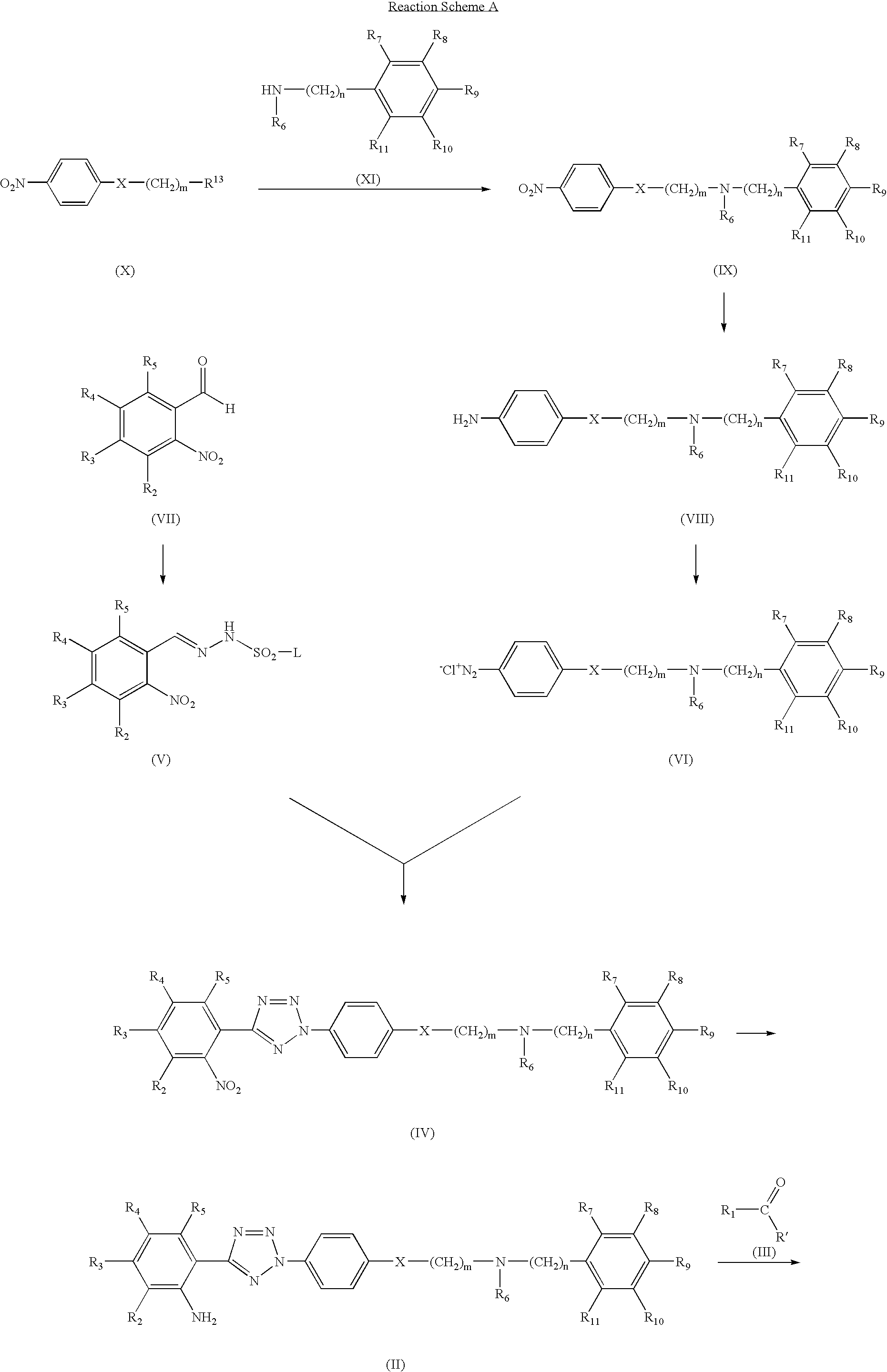P-glycoprotein inhibitor, method for preparing the same and pharmaceutical composition comprising the same
a p-glycoprotein inhibitor and a technology of p-glycoprotein, which are applied in the direction of drug compositions, biocide, animal repellents, etc., can solve the problems of toxicity and other problems of p-glycoprotein inhibitors, and achieve the effect of enhancing the bioavailability of an anticancer agent and minimizing adverse effects
- Summary
- Abstract
- Description
- Claims
- Application Information
AI Technical Summary
Benefits of technology
Problems solved by technology
Method used
Image
Examples
example 1
Synthesis of quinoline-3-carboxylic acid [2-(2-4-[2-(6,7-dimethoxy-3,4-dihydro-1H-isoquinolin-2-yl)-ethyl]-phenyl-2H-tetrazol-5-yl)-4,5-dimethoxy-phenyl]-amide
Step 1: Preparation of 4-[2-(6,7-dimethoxy-3,4-dihydro-1H-isoquinolin-2-yl)-ethyl]-phenylamine
[0084]2.30 g of 2-(4-nitrophenyl)ethane bromide and 2.29 g of 6,7-dimethoxy-1,2,3,4-tetrahydroisoquinoline hydrochloride were dissolved in 150 ml of N,N′-dimethylformamide, 4.15 g of potassium carbonate and 1.80 g of sodium iodide were added thereto, and the mixture was allowed to react at 100° C. for 12 hours. After mixing 150 ml of water, the reaction mixture was extracted three times with 200 ml portion of ethylacetate, and the combined organic layer was washed with saturated NaCl and dried over magnesium sulfate. The resulting solution was subjected to a reduced pressure to remove the solvent, and the residue was recrystallized using ethylacetate, to obtain 2.40 g of a nitro derivative. The nitro derivative was added to a mixture ...
example 2
Synthesis of quinoline-2-carboxylic acid [2-(2-{4-[2-(6,7-dimethoxy-3,4-dihydro-1H-isoquinolin-2-yl)-ethyl]-phenyl}-2H-tetrazol-5-yl)-4,5-dimethoxy-phenyl]-amide
[0096]0.15 g of the compound obtained in Step 4 of Example 1 and 0.05 g of quinaldic acid were added to 5 ml of dichloromethane, 0.1 g of 1-(3-dimethylaminopropyl)-3-ethylcarbodiimide hydrochloride and 0.005 g of 4-(dimethylamino)pyridine were added thereto, and the mixture was kept at room temperature for 12 hours. After washing with 50 ml of distilled water, the organic layer was separated and dried over magnesium sulfate, filtrated, and distilled under a reduced pressure. The residue was subjected to column chromatography to obtain 0.14 g of the title compound (yield 73%).
[0097]1H-NMR(CDCl3) δ: 12.60 (s, 1H), 8.71 (s, 1H), 8.40 (d, 2H), 8.20 (d, 2H), 8.13 (d, 1H), 7.90 (s, 2H), 7.65 (m, 2H), 7.37 (d, 2H), 6.58 (d, 2H), 4.05 (d, 6H), 3.85 (s, 6H), 3.67 (s, 2H), 3.01 (t, 2H), 2.83 (m, 6H)
example 3
Synthesis of isoquinoline-3-carboxylic acid [2-(2-{4-[2-(6,7-dimethoxy-3,4-dihydro-1H-isoquinolin-2-yl)-ethyl]-phenyl}-2H-tetrazol-5-yl)-4,5-dimethoxy-phenyl]-amide
[0098]The procedure of Example 2 was repeated except for using 3-isoquinoline carboxylic acid hydrate instead of quinaldic acid to obtain 0.12 g of the title compound (yield 62%).
[0099]1H-NMR(CDCl3) δ: 12.67 (s, 1-H), 9.29 (s, 1H), 8.83 (s, 1H), 8.73 (s, 1H), 8.41 (d, 2H), 8.01 (d, 2H), 7.93 (s, 1H), 7.77 (m, 2H), 7.53 (d, 2H), 6.62 (s, 1H), 6.57 (s, 1H), 4.04 (d, 6H), 3.85 (s, 6), 3.72 (s, 2H), 3.07 (t, 2H), 2.86 (m, 6H)
PUM
| Property | Measurement | Unit |
|---|---|---|
| temperature | aaaaa | aaaaa |
| boiling point | aaaaa | aaaaa |
| boiling point | aaaaa | aaaaa |
Abstract
Description
Claims
Application Information
 Login to View More
Login to View More - R&D
- Intellectual Property
- Life Sciences
- Materials
- Tech Scout
- Unparalleled Data Quality
- Higher Quality Content
- 60% Fewer Hallucinations
Browse by: Latest US Patents, China's latest patents, Technical Efficacy Thesaurus, Application Domain, Technology Topic, Popular Technical Reports.
© 2025 PatSnap. All rights reserved.Legal|Privacy policy|Modern Slavery Act Transparency Statement|Sitemap|About US| Contact US: help@patsnap.com



